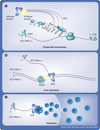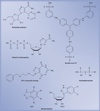Helicase inhibitors as specifically targeted antiviral therapy for hepatitis C
- PMID: 20161209
- PMCID: PMC2714653
- DOI: 10.2217/fvl.09.7
Helicase inhibitors as specifically targeted antiviral therapy for hepatitis C
Abstract
The hepatitis C virus (HCV) leads to chronic liver disease and affects more than 2% of the world's population. Complications of the disease include fibrosis, cirrhosis and hepatocellular carcinoma. Current therapy for chronic HCV infection, a combination of ribavirin and pegylated IFN-alpha, is expensive, causes profound side effects and is only moderately effective against several common HCV strains. Specifically targeted antiviral therapy for hepatitis C (STAT-C) will probably supplement or replace present therapies. Leading compounds for STAT-C target the HCV nonstructural (NS)5B polymerase and NS3 protease, however, owing to the constant threat of viral resistance, other targets must be continually developed. One such underdeveloped target is the helicase domain of the HCV NS3 protein. The HCV helicase uses energy derived from ATP hydrolysis to separate based-paired RNA or DNA. This article discusses unique features of the HCV helicase, recently discovered compounds that inhibit HCV helicase catalyzed reactions and HCV cellular replication, and new methods to monitor helicase action in a high-throughput format.
Figures





Similar articles
-
Hepatitis C (HCV) Agents.2022 Feb 7. LiverTox: Clinical and Research Information on Drug-Induced Liver Injury [Internet]. Bethesda (MD): National Institute of Diabetes and Digestive and Kidney Diseases; 2012–. 2022 Feb 7. LiverTox: Clinical and Research Information on Drug-Induced Liver Injury [Internet]. Bethesda (MD): National Institute of Diabetes and Digestive and Kidney Diseases; 2012–. PMID: 31644192 Free Books & Documents. Review.
-
Ebselen inhibits hepatitis C virus NS3 helicase binding to nucleic acid and prevents viral replication.ACS Chem Biol. 2014 Oct 17;9(10):2393-403. doi: 10.1021/cb500512z. Epub 2014 Aug 15. ACS Chem Biol. 2014. PMID: 25126694 Free PMC article.
-
A macrocyclic HCV NS3/4A protease inhibitor interacts with protease and helicase residues in the complex with its full-length target.Proc Natl Acad Sci U S A. 2011 Dec 27;108(52):21052-6. doi: 10.1073/pnas.1110534108. Epub 2011 Dec 12. Proc Natl Acad Sci U S A. 2011. PMID: 22160684 Free PMC article.
-
Analysis of the Enzymatic Activity of an NS3 Helicase Genotype 3a Variant Sequence Obtained from a Relapse Patient.PLoS One. 2015 Dec 10;10(12):e0144638. doi: 10.1371/journal.pone.0144638. eCollection 2015. PLoS One. 2015. PMID: 26658750 Free PMC article.
-
Hepatitis C virus NS3 inhibitors: current and future perspectives.Biomed Res Int. 2013;2013:467869. doi: 10.1155/2013/467869. Epub 2013 Oct 27. Biomed Res Int. 2013. PMID: 24282816 Free PMC article. Review.
Cited by
-
Optimization of potent hepatitis C virus NS3 helicase inhibitors isolated from the yellow dyes thioflavine S and primuline.J Med Chem. 2012 Apr 12;55(7):3319-30. doi: 10.1021/jm300021v. Epub 2012 Mar 22. J Med Chem. 2012. PMID: 22409723 Free PMC article.
-
RNA Helicases as Shadow Modulators of Cell Cycle Progression.Int J Mol Sci. 2021 Mar 15;22(6):2984. doi: 10.3390/ijms22062984. Int J Mol Sci. 2021. PMID: 33804185 Free PMC article. Review.
-
In-silico screening for anti-Zika virus phytochemicals.J Mol Graph Model. 2016 Sep;69:78-91. doi: 10.1016/j.jmgm.2016.08.011. Epub 2016 Aug 28. J Mol Graph Model. 2016. PMID: 27588363 Free PMC article.
-
Plant-Derived Purification, Chemical Synthesis, and In Vitro/In Vivo Evaluation of a Resveratrol Dimer, Viniferin, as an HCV Replication Inhibitor.Viruses. 2019 Sep 23;11(10):890. doi: 10.3390/v11100890. Viruses. 2019. PMID: 31547617 Free PMC article.
-
Coronavirus helicases: attractive and unique targets of antiviral drug-development and therapeutic patents.Expert Opin Ther Pat. 2021 Apr;31(4):339-350. doi: 10.1080/13543776.2021.1884224. Epub 2021 Apr 21. Expert Opin Ther Pat. 2021. PMID: 33593200 Free PMC article. Review.
References
Bibliography
-
- HCV Working Group. Global burden of disease (GBD) for hepatitis C. J. Clin. Pharmacol. 2004;44:20–29. - PubMed
-
- McHutchison JG. Understanding hepatitis C. Am. J. Manag. Care. 2004;10:S21–S29. - PubMed
-
- Habib M, Mohamed MK, Abdel-Aziz F, et al. Hepatitis C virus infection in a community in the Nile delta: risk factors for seropositivity. Hepatology. 2001;33:248–253. - PubMed
-
- Maheshwari A, Ray S, Thuluvath PJ. Acute hepatitis C. Lancet. 2008;372:321–332. - PubMed
-
- Hu KQ, Tong MJ. The long-term outcomes of patients with compensated hepatitis C virus-related cirrhosis and history of parenteral exposure in the United States. Hepatology. 1999;29:1311–1316. - PubMed
Websites
-
- UCSF Chimera: an extensive molecular modeling system. www.cgl.ucsf.edu/chimera/
-
- UCSF DOCK. http://dock.compbio.ucsf.edu/
-
- Adaptive Poisson-Boltzmann solver. http://apbs.sourceforge.net/
-
- PyMOL. www.pymol.org/
Grants and funding
LinkOut - more resources
Full Text Sources
Other Literature Sources
Miscellaneous
